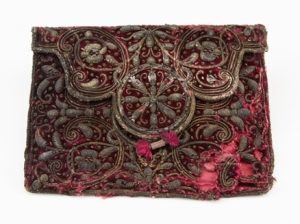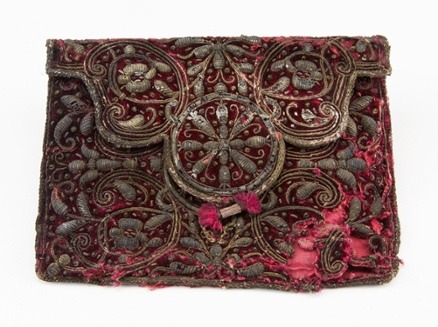
UNIVERSITY OF AMSTERDAM—‘Rarely, if ever, has such a big discovery been made in a maritime context’, says Maarten van Bommel, Professor of Conservation Science and chair of the section Restoration and Conservation of Cultural Heritage at the UvA. The items, which were found at the wreck of a 17th-century ship in the Wadden Sea near Texel, include a very luxurious gown that has remained remarkably well preserved. This gown serves as the showpiece of the temporary exhibition ‘Garde Robe’, which has opened at the museum, Kaap Skil.
The gown, which due to its rich detail is believed to have belonged to ‘high nobility, possibly even royalty’, is part of an extensive wardrobe. Among other articles, the site also yielded a cloak, stockings and silk and satin bodices decorated with large quantities of gold and silver thread. In addition to textiles, divers also found practical items like pottery from Italy, a gilded silver chalice and scents from Greece or Turkey. In addition, a number of book covers emerged from the depths that bear the coat of arms of the English Royal House of Stuart.
International importance
Experts from the Rijksmuseum, the University of Amsterdam and the Cultural Heritage Agency of the Netherlands (RCE), consider the textiles one of Europe’s most important clothing finds ever. Their discovery, in combination with other objects, makes this one of the foremost and most appealing finds in the history of Dutch archaeology. Because in a ship everything is preserved together – as if in a time capsule – this discovery can give great insight into the life and work of those on board and the trade relations and political situation of the time.
_____________________________________________________ 
One of the wardrobe items found at the site of the shipwreck. Credit Kaap Skil
_______________________________________________________
Who wore it?
Archival research revealed that the wardrobe belonged to the royal court of the English queen Henrietta Maria. In March 1642 the queen was travelling to the Netherlands on a secret mission when one of her baggage ships sunk in the Wadden Sea. This discovery was made by cultural historians Helmer Helmers from the University of Amsterdam (UvA) and Nadine Akkerman from Leiden University. It probably belonged to Jean Kerr, Countess of Roxburghe (c. 1585-1643), lady-in-waiting and confidante to Queen Henrietta Maria (1609-1669). Jean was one of two ladies-in-waiting whose clothes went down with the ship, but the style and size of the gown indicates strongly that it belonged to Kerr, the elder of the two.
Elizabeth Stuart
Cultural historians Nadine Akkerman and Helmer Helmers are experts on the British Royal House of Stuart. Their findings are based on a letter written by Elizabeth Stuart (1596-1662), the Stuart princess who found refuge in The Hague after being exiled from the Kingdom of Bohemia. In a letter to the English diplomat Sir Thomas Roe, dated 17 March 1642, Elizabeth describes how her sister-in-law lost a baggage ship during the crossing. In addition to the clothing of two ladies-in-waiting and their maids, the queen herself lost the ‘vessels’ from her private chapel in the shipwreck.
A secret mission
The official story behind Henrietta Maria’s trip to the Dutch Republic was one of royal connections: she was delivering her 11-year old daughter Mary to the court of William II, Prince of Orange and future stadtholder, whom the girl had married the previous year. This was only a ruse, however: her real mission was to sell the crown jewels and use the proceeds to buy weapons. These were essential for King Charles I to take on Parliament in the English Civil War. According to Akkerman and Helmers, the find at Texel represents a tangible reminder of the strong Dutch involvement in this conflict.
Winter Queen
Akkerman, assistant professor of Early Modern English Literature at Leiden University, and Helmers, assistant professor of Early Modern Dutch Literature and Culture at the UvA, were able to solve the mystery of the unknown gown owner reasonably quickly. Akkerman: ‘Once Helmer alerted me to the find, it took us about five minutes to unearth the relevant letter, as I remembered transcribing and deciphering it in 2006. We continue to find more references.’
Akkerman is the editor of the Correspondence of Elizabeth Stuart, Queen of Bohemia, while Helmers is the author of The Royalist Republic, on Anglo-Dutch relations in this period.
Unnecessary speculation
The mystery and speculation in the Dutch press surrounding the origin of the wardrobe were unnecessary. With the discovery of the family crest, the evidence quickly started pointing towards the Stuarts. Helmers: ‘It is a pity we weren’t consulted earlier – the puzzle would have been solved much earlier. The archaeological experts have primarily focused on the material side. Of course this is important, but the historical texts also tell a thrilling story.’
Shipwrecks of the Texel Roadstead
Off the coast of Texel, at Oudeschild, lie hundreds of shipwrecks, many from the Golden Age. Waiting for cargo or a favorable wind, they went down in storms and severe weather. However, their contents were well preserved under the sand. Due to the changing sea currents, the wrecks sometimes come loose, often threatening their cargo. Various organizations responsible for preserving these sites are currently investigating how best to deal with these processes. They are working together in this context with the Texel Diving Club, which called attention to this find.
Exhibition opening
The exhibition Garde Robe was officially opened on Thursday, 14 April, on behalf of all parties involved, by Jack van der Hoek, member of the Provincial Executive of North Holland. The spectacular opening ceremony was directed by Studio Aziz Bekkaoui. During the opening, well-known UvA archaeologist Prof. Jerzy Gawronski admitted that it was a huge surprise to him that the seabed around Texel is home to such treasures. Provincial Executive member Jack van der Hoek said he saw it as a great gift, which also entails a great responsibility.
Museum Kaap Skil will be showing a selection of the find to the public for a month – until Monday, 16 May 2016. After that, the objects will be transferred to Huis van Hilde (Hilde’s House), the archaeology information centre of the Province of North Holland, where the research will be conducted. The University of Amsterdam, RCE and the Rijksmuseum will be closely involved in this research. The Province of North Holland, which acquired ownership of the find, is in charge of the investigation. Eventually, the find will be exhibited in museum Kaap Skil on Texel.
Source: Adapted and edited from press releases of the University of Amsterdam.
__________________________________________________________

______________________________________________
Travel and learn with Far Horizons.
____________________________________________
This richly illustrated issue includes the following stories: Recent findings shedding new light on the whereabouts of the remains of Philip of Macedon, father of Alexander the Great; how an archaeologist-sculptor is bringing bones of the dead back to life; archaeologists uncovering town life at the dawn of civilization; an exclusive interview with internationally acclaimed archaeologist James M. Adovasio about what makes the Meadowcroft Rockshelter prominent in the ongoing search for the first Americans; what archaeologists are finding at the site of the ancient city of Gath, the home town of the biblical Philistine giant, Goliath; and how scientists are redrawing the picture of human evolution in Europe. Find it on Amazon.com.







